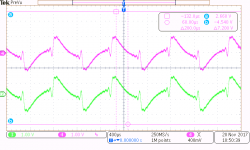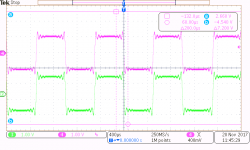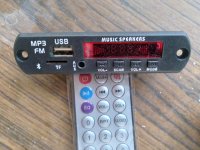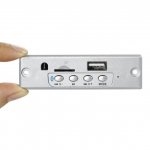Do you want a device that has its own display or are you willing to connect it to a separate display/TV?
That makes sense as the USB port is on the front! 😎
I like to make audio test signals with Adobe Audition. The Dell desktop supplied at work puts out something
vaguely resembling a square wave. This was worthless as a test signal and made lousy audio for playing music.
Boss got me one of these
https://www.amazon.com/StarTech-com...ocphy=9030961&hvtargid=pla-338189065906&psc=1
which puts out textbook audio and is a good value. Remember that "ringing" is the Gibbs phenomenon and
happens because the bandwidth is limited, not because of some fault in the system.
Gibbs phenomenon - Wikipedia
And if you have not seen this, you should.
https://xiph.org/video/vid2.shtml
G²
Attachments
Thanks for all your suggestions. I managed to bag a used one of these for not very much, works perfectly. Dune HD Smart D1 High Definition Expandable Network Media with 1080p Upscaling : Amazon.co.uk: Electronics & Photo


$2 here, and with power supply, cabinet and RCA ports, $5.
FM, SD card, USB stick, Bluetooth, even an aux input.
FM, SD card, USB stick, Bluetooth, even an aux input.
Attachments
Last edited:
FM, SD card, USB stick, Bluetooth, even an aux input.
So what bit rate and sound file formats does it support? The Dune will play up to 24bit 192kHz and just about any file format, plus the usb requirement now becomes redundant as it has an internal 1Tb hard drive.
So what bit rate and sound file formats does it support? The Dune will play up to 24bit 192kHz and just about any file format, plus the usb requirement now becomes redundant as it has an internal 1Tb hard drive.
The contribution is a bit late to the party and, without including specifications, the suitability of such an inexpensive device is questionable.
Features:
You need Amplifier Board and Speaker to use this Module. Bluetooth FM USB MP3 Audio Board with LED Display
With IR Remote Control: Yes
With the LINE input (AUX) Song Number Display: Yes Supports: Bluetooth/ FM/ USB/ MP3/ AUX/ SD
Frequency Range: 87.5-108 MHz
Led Seven Segment Display
Support: 32-320 kbps MP3 Songs
Support: FAT 32, FAT 16 File System
External Antenna
This unit is used to feed a Amplifier, from Amplifier you can drive Speaker.
Do not connect Speakers directly to this unit.
Power and Output Specification: Input Supply: 5V (You can use regulator IC LM7805 to bring the supply to 5V)
S/N: 65dB
Distortion: 0.2%
Output: 550 mV
Separation: 45 dB
Auto-Search Station: 22-28 dB
Frequency Response: (90 Hz - 15 kHz)
Dimensions: Length: 41mm Width: 32mm
(This is for the $2 module)
I am using this type of module in my car to play 48 kHz 320 kbps MP3. The unit has a pair of 4440 ICs as the amp.
It works, and cost only $5 for the amp, speakers, wire and labor were extra.
You need Amplifier Board and Speaker to use this Module. Bluetooth FM USB MP3 Audio Board with LED Display
With IR Remote Control: Yes
With the LINE input (AUX) Song Number Display: Yes Supports: Bluetooth/ FM/ USB/ MP3/ AUX/ SD
Frequency Range: 87.5-108 MHz
Led Seven Segment Display
Support: 32-320 kbps MP3 Songs
Support: FAT 32, FAT 16 File System
External Antenna
This unit is used to feed a Amplifier, from Amplifier you can drive Speaker.
Do not connect Speakers directly to this unit.
Power and Output Specification: Input Supply: 5V (You can use regulator IC LM7805 to bring the supply to 5V)
S/N: 65dB
Distortion: 0.2%
Output: 550 mV
Separation: 45 dB
Auto-Search Station: 22-28 dB
Frequency Response: (90 Hz - 15 kHz)
Dimensions: Length: 41mm Width: 32mm
(This is for the $2 module)
I am using this type of module in my car to play 48 kHz 320 kbps MP3. The unit has a pair of 4440 ICs as the amp.
It works, and cost only $5 for the amp, speakers, wire and labor were extra.
Last edited:
I just found out, not that I need it, but you can get a digital TV USB stick for the Dune for £10 to pick up terrestrial digital TV.
I can take the memory stick with me, no thief will bother to steal the radio/amp , and it is totally solid state, a big advantage in cars driven over bumpy roads.
Also I can change the music when I tire of it.
Currently using a $4 32 GB stick, hundreds of songs on it.
Also I can change the music when I tire of it.
Currently using a $4 32 GB stick, hundreds of songs on it.
Last edited:
Does it support FLAC files, the format in which the OP has stored his music?Features:
I don't need it for the car, it's for in the house to connect to 1960 equipment, or anything else. I have a £200 digital/analogue radio in the car that does far more things than I will ever need. I didn't buy it, it was standard equipment in the car.
I will see, I have Whitney Houston on my hard disk, FLAC or Ogg Vorbis, will put on USB and check.
Update tomorrow, it is 1030 pm or so here...
Update tomorrow, it is 1030 pm or so here...
Oh, the modules come from China...
Here they are used for car radios, in amplifiers for home or PA use, and for whatever else people think up, those are made in India, the chips are mostly Chinese too.
The sheet metal, transformers, pots, PCB, knobs, jacks etc. are Indian.
One version is for people like you, who need to add USB and Bluetooth to their audio systems, for that a sort of pre amp is sold for about $5.
It has this module, a housing, built in power supply, and RCA jacks.
Like in your photo, this sits outside your system.
Some technicians remove the existing analog radios and put this module in place in audio systems, a bit of Frankenstein to me...
The FM is clearer than the old capacitor tuned radios. And remote makes it easier to change stations.
Here they are used for car radios, in amplifiers for home or PA use, and for whatever else people think up, those are made in India, the chips are mostly Chinese too.
The sheet metal, transformers, pots, PCB, knobs, jacks etc. are Indian.
One version is for people like you, who need to add USB and Bluetooth to their audio systems, for that a sort of pre amp is sold for about $5.
It has this module, a housing, built in power supply, and RCA jacks.
Like in your photo, this sits outside your system.
Some technicians remove the existing analog radios and put this module in place in audio systems, a bit of Frankenstein to me...
The FM is clearer than the old capacitor tuned radios. And remote makes it easier to change stations.
Last edited:
Basically, in amps this has 4 versions:
4440 based, about 10 w/channel
STK 4141 based, about 20 w/channel
2N3055/2955 based, 40W/channel
Mosfet based, 80 W/channel.
Many makers, almost generic.
Sold by output level and price.
Paid $10 for a amp with FM, 4440 based.
I can switch to direct Mic, and use as PA amp, and also connect to 12V, apart from mains (220 here).
Versatile.
4440 based, about 10 w/channel
STK 4141 based, about 20 w/channel
2N3055/2955 based, 40W/channel
Mosfet based, 80 W/channel.
Many makers, almost generic.
Sold by output level and price.
Paid $10 for a amp with FM, 4440 based.
I can switch to direct Mic, and use as PA amp, and also connect to 12V, apart from mains (220 here).
Versatile.
https://www.eassymall.com/product/j...MIlM-ZtqaP9AIVx5NmAh3EawUqEAQYAyABEgJqN_D_BwE
My player did not play the Ogg Vorbis file, which is different from FLAC, I think.
The one linked to above claims to do so.
Another way is to use the Bluetooth function on the module, and send it files from tablet / smart phone.
Then you get to play files with names and so on.
Come to think of it, most smartphones have lots of processor cores and RAM, about the same as older desk top computers.
My player did not play the Ogg Vorbis file, which is different from FLAC, I think.
The one linked to above claims to do so.
Another way is to use the Bluetooth function on the module, and send it files from tablet / smart phone.
Then you get to play files with names and so on.
Come to think of it, most smartphones have lots of processor cores and RAM, about the same as older desk top computers.
Unfortunately, your link gives a "page does not exist" error.
The remit was to suggest a device that would play FLAC files from a USB memory stick, and that has been fulfilled.
It's always interesting, however, to hear of inexpensive devices which may solve other connectivity problems.
The remit was to suggest a device that would play FLAC files from a USB memory stick, and that has been fulfilled.
It's always interesting, however, to hear of inexpensive devices which may solve other connectivity problems.
Correction!
Your link, which did not open on my tablet, has opened on my laptop!
And, as you said, it handles FLAC files.
Your link, which did not open on my tablet, has opened on my laptop!
And, as you said, it handles FLAC files.
Attachments
Last edited:
- Home
- Source & Line
- Digital Source
- USB stick digital audio to analogue.



